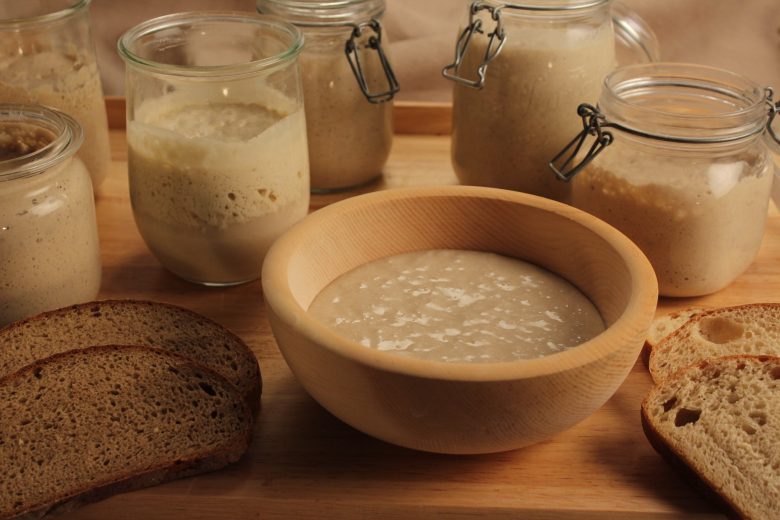Sourdough
Sourdough is the oldest and most common way to leaven and flavor bread. It is prepared by mixing some rye flour and water as a pre-dough and can either be spontaneously fermented or by the addition of a starter.
The sourdough…
- Leavens to dough
- Sours the dough
- Contributes to the flavor development
- Lengthens the shelf life of the bread
- Delays spoilage from mold
The acidity required for the production of bread containing rye depends on the type of flour and the flour mixture. Rye bread made without dough acidification produces a more or less inelastic, hardly bakeable bread crumb and a sticky, bland taste in the bread. Sourdough gives rye better baking properties!
Sourdough management is less complex and less problematic than often assumed. The following points must be observed:
The start phase
The starting conditions are particularly important for sourdoughs. At sourdough temperatures below 20°C, the increase in acidity is significantly pronounced. Sourdough temperature and firmness characterize the sourdough from the beginning “mildly sour at high temperatures” and “strong and sour at low temperature”. The sourdough temperature is variable with each processing method. In the same way, the temperature depends on the amount of starter and the consistency of the dough (TA).
How much sourdough should I use?
- As a rule of thumb, 30-50% of the total amount of rye flour is acidified.
- For reasons of taste, one deviates from this basic rule for the bread as follows:
- Flour mix (ratio between rye and wheat)
- Sourdough management
- Recipe composition
- Desired bread flavor
Grow sourdough culture yourself
To make sourdough, a starter is required.
„Simple, easier starter“
On the first day, 100g wholegrain rye flour and 100g water (30°C) are mixed together to form a paste in a container. The container is then covered and left in a warm place for 24 hours. It is important that the dough is always stored in a warm place and does not cool down (30°C).
On the second day, 100g wholegrain rye flour and 100g water are added to the dough. Stir until lump-free and leave it covered again in a warm place. To guarantee success, it is advisable to stir the dough with a wooden spoon again after 12 hours.
This process is repeated for another 3 days. If liquid settles on the top, this is not a problem, since it is the alcoholic fermentation.
After a few days, the starter will form bubbles, rise and smell sour.
“A sign of success”
On the 6th day, your starter should be finished and ready for further processing.
But since you now have 1000g of starter and only need 100-150g, the rest is disposed of or it is kept in reserve (see How do I preserve sourdough). Your starter can be kept in the refrigerator for 1-2 weeks.
In order to keep the sourdough healthy and always strong, it is advisable to feed it. This is done by mixing in water and rye flour in the same proportion and then letting it stand.
It is important to always mix the starter in a clean container
Factors that impact the sourdough process:
- Flours with a high bran content have more nutrition to give the microorganisms than lighter flours. These are better for souring as opposed to flours with a lower type number.
- Strong and active starter is a prerequisite for error-free sourdough.
- The standing time of a sourdough can be between 4-18 hours depending on the method used.
- The hydration (TA) determines the firmness of a sourdough. This affects the maturation time for the dough. Firmer sourdoughs (TA160) need a longer standing time. Due to the low microorganism activity, they ripen more slowly and a more intensive development of the aromatic compounds (acetic acid) is favored. Soft doughs (TA240) require a shorter standing time because lactic acid bacteria and sourdough yeasts develop more quickly.
- The sourdough temperature should be between 35°C as a maximum and 20°C. Warmer temperatures favor the lactic acid bacteria and the yeast. Cooler sourdoughs lead to the development of acetic acid.
What is sourdough made of?
Lactic acid bacteria
These bacteria prefer temperatures of 30-35 ° C. They are the basis of life for sourdough yeast.
“HOMOFERMENTATIVE”
Acetic acid bacteria
These microorganisms are mainly responsible for the taste of the bread. They love the temperature 25-27 ° C.
HETEROFERMENTATIVE
Sourdough yeast
Sourdough yeasts produce carbon dioxide and are therefore responsible for loosening the bread. The difference to baker’s yeast is that it needs the acid to multiply. Therefore, the sourdough must first become sour so that the yeast can take effect in the dough.
Temperatures:
Temperatures less than 30°C lead to
- A good balance
- a somewhat tight crumb with a small volume
- a sour taste in the bread
Temperatures above 30°C lead to
- Somewhat moist doughs
- A flexible crumb
- A larger crumb opening
- A darker crumb
- A mildly aromatic bread taste
Consistency:
Sourdough hydrations (TA) less than 80% (180) lead to
- Tight crumb
- Coarse-pored crumb
- Fuller flavor
Sourdough hydrations (TA) above 100% (200) lead to
- Softer crumb
- Finer pored crumb
- Milder bread flavor
Sourdough police
Also known as the “sourdough police”, spices such as anise and caraway seeds are added to the sourdough in ground form, as their essential oils inhibit undesired foreign fermentation and ensure a pure sourdough.


